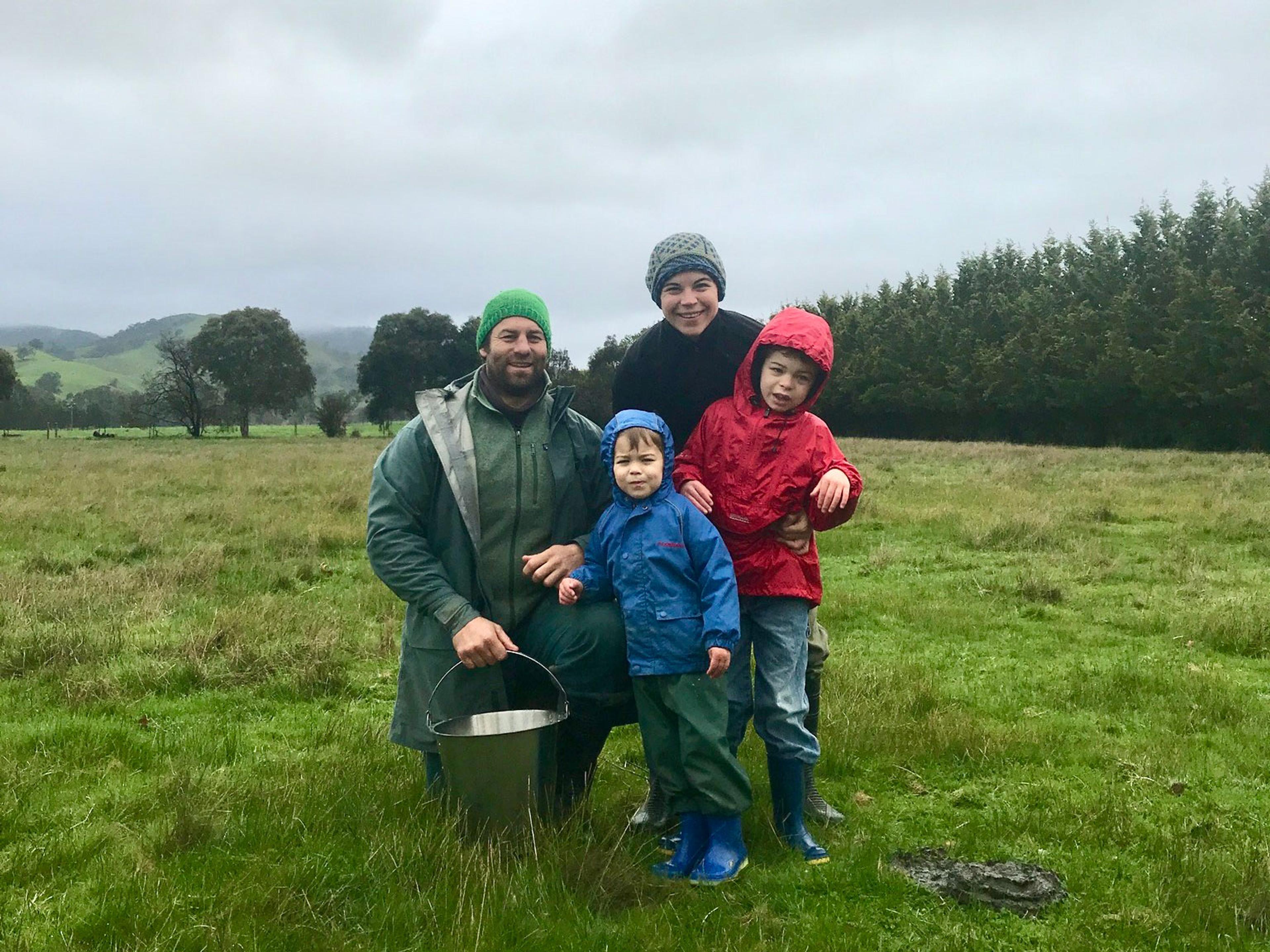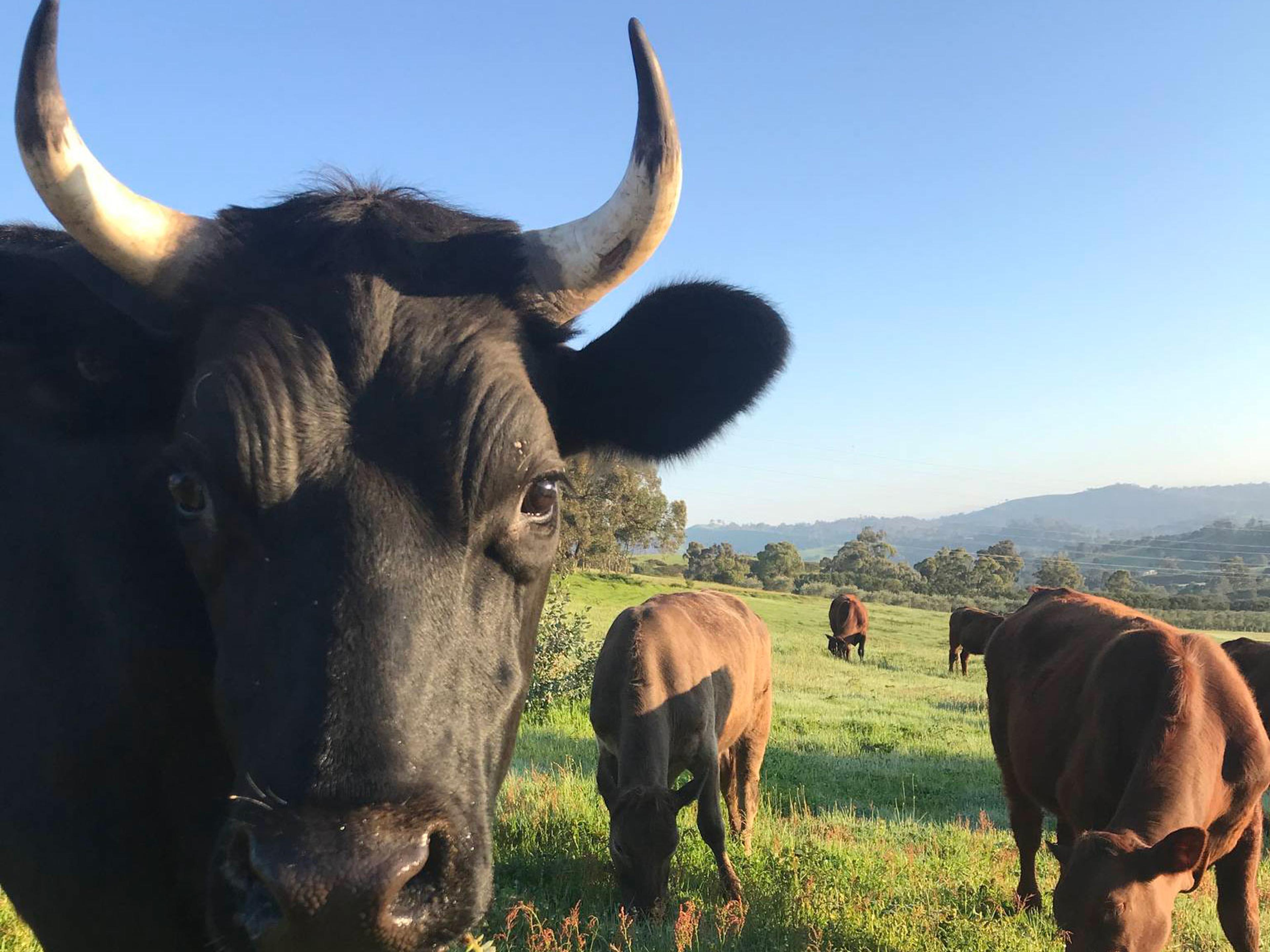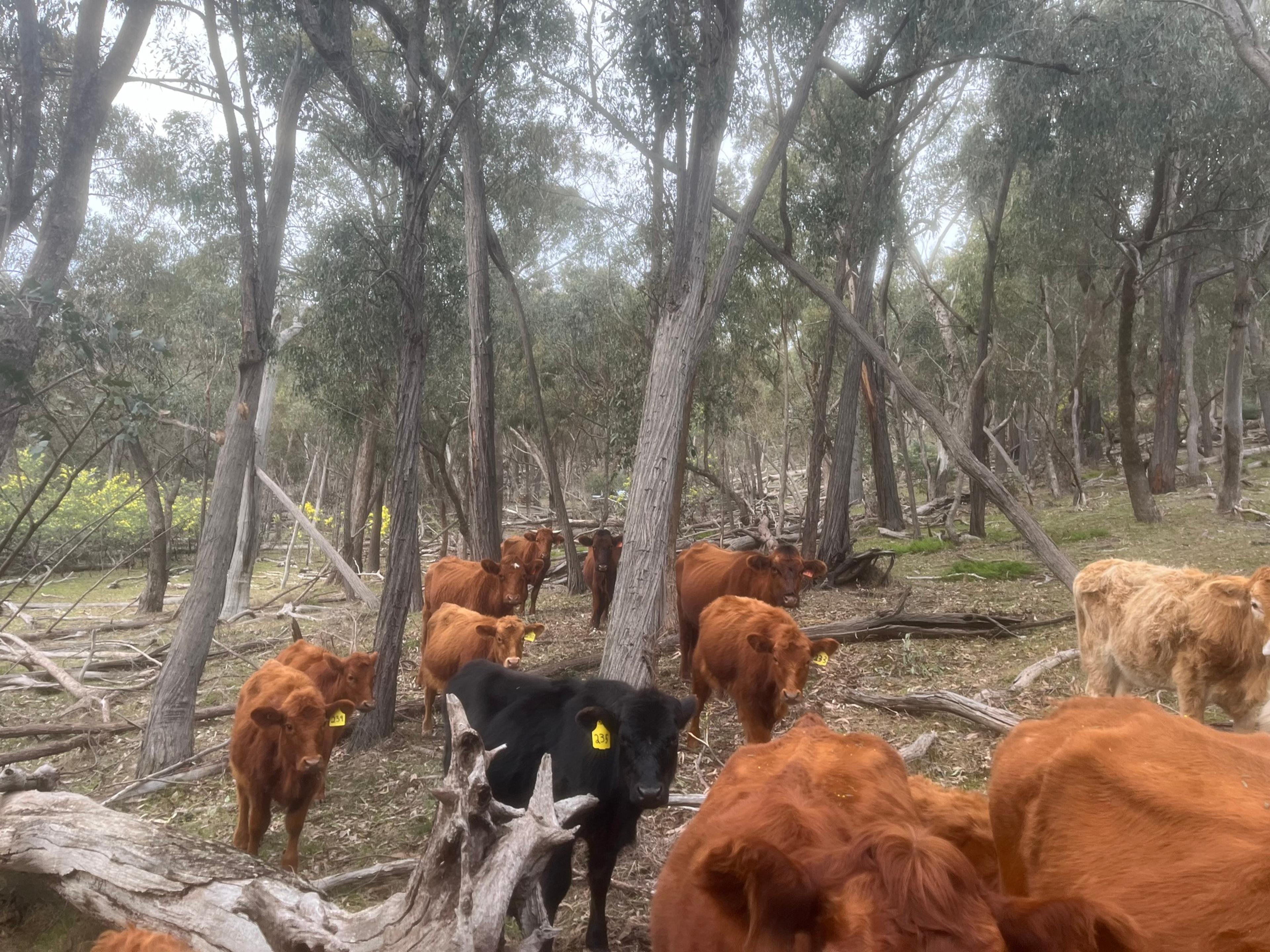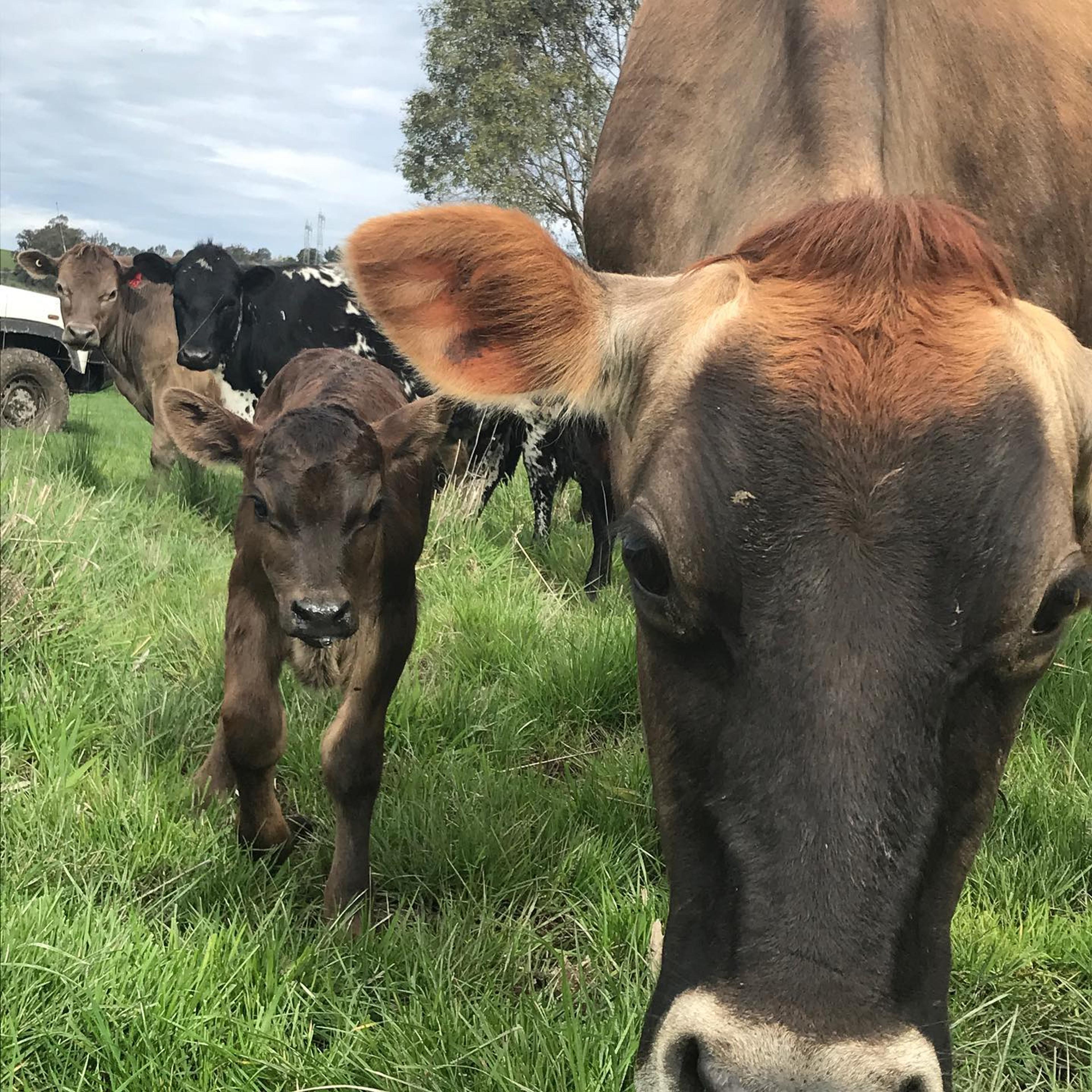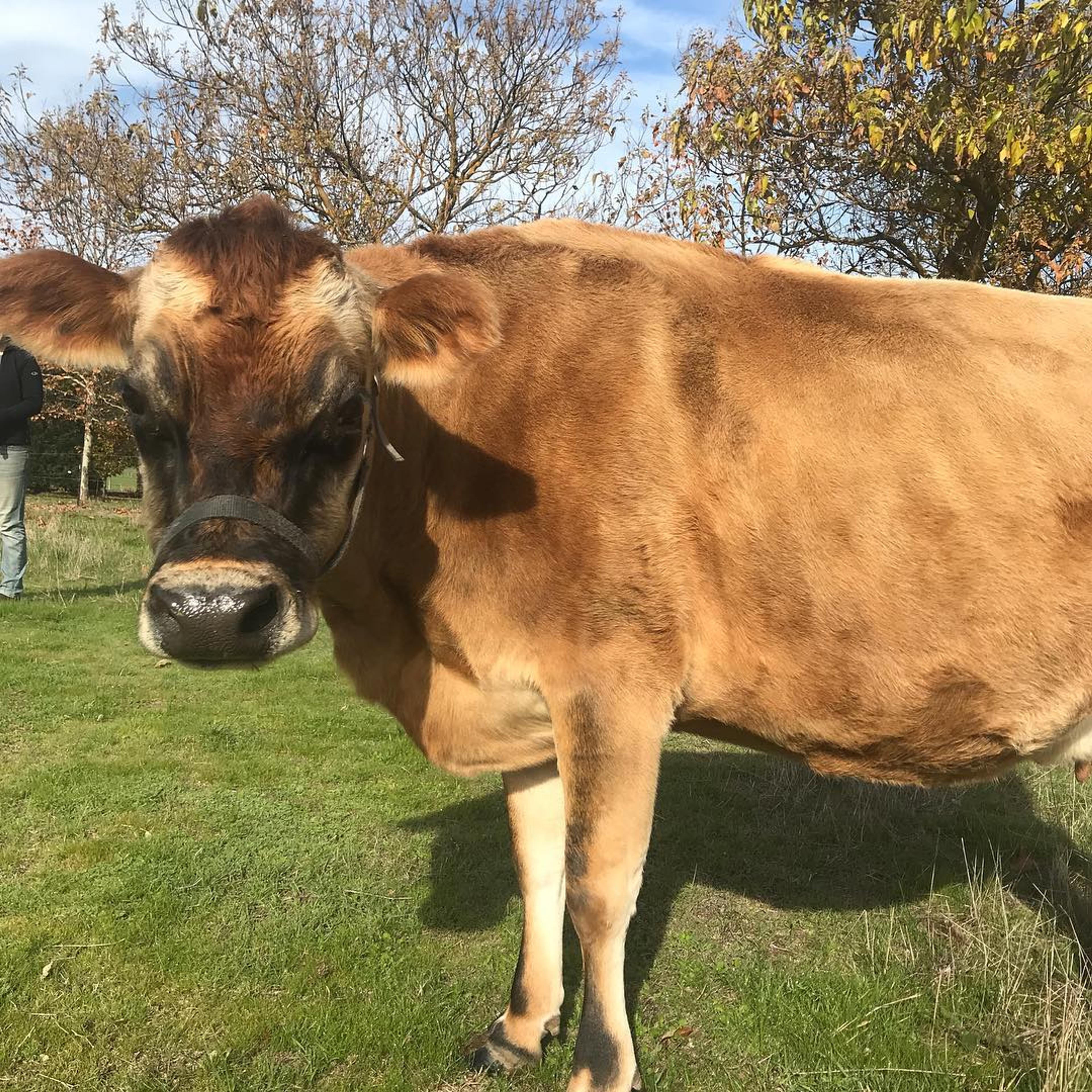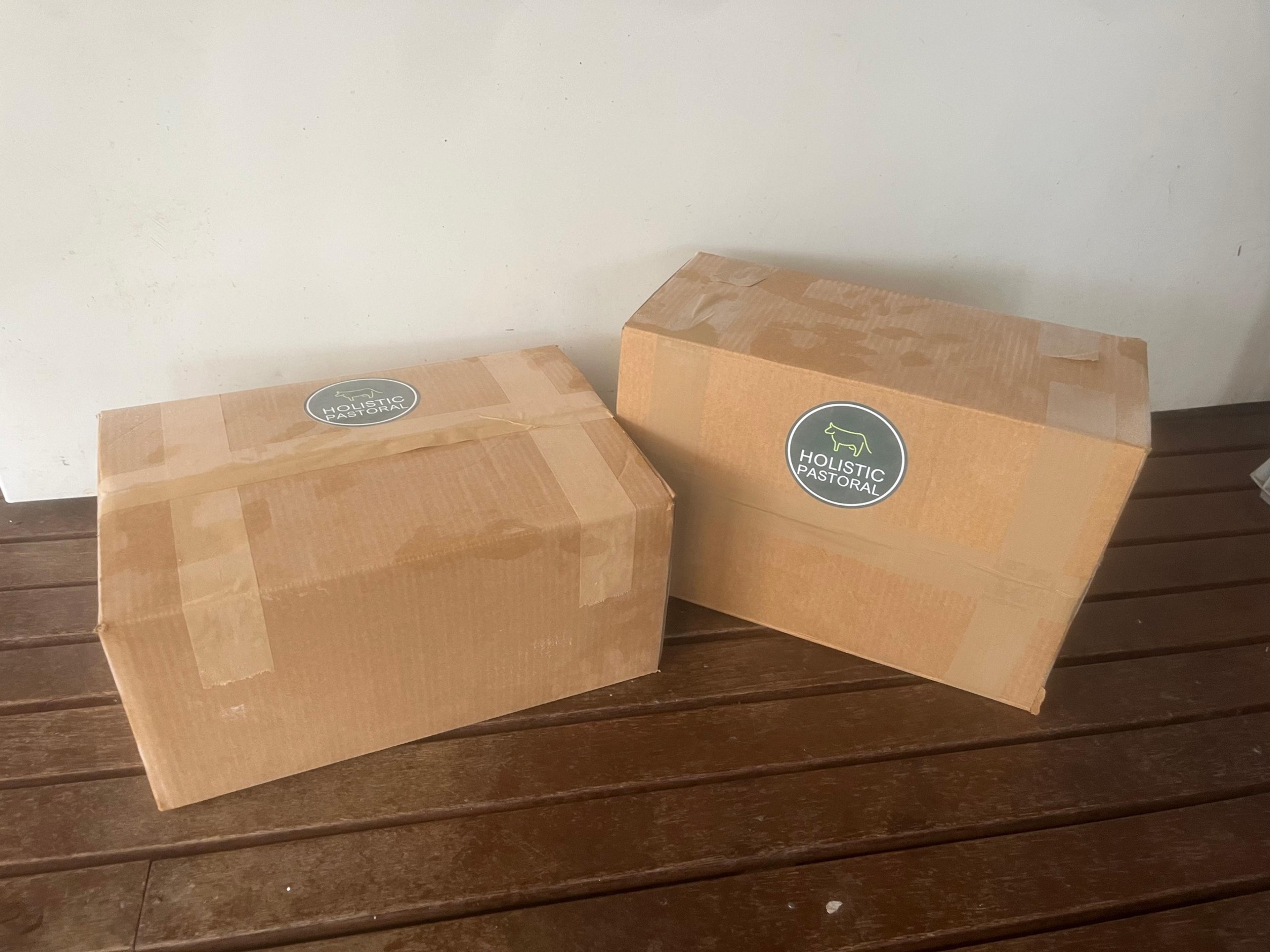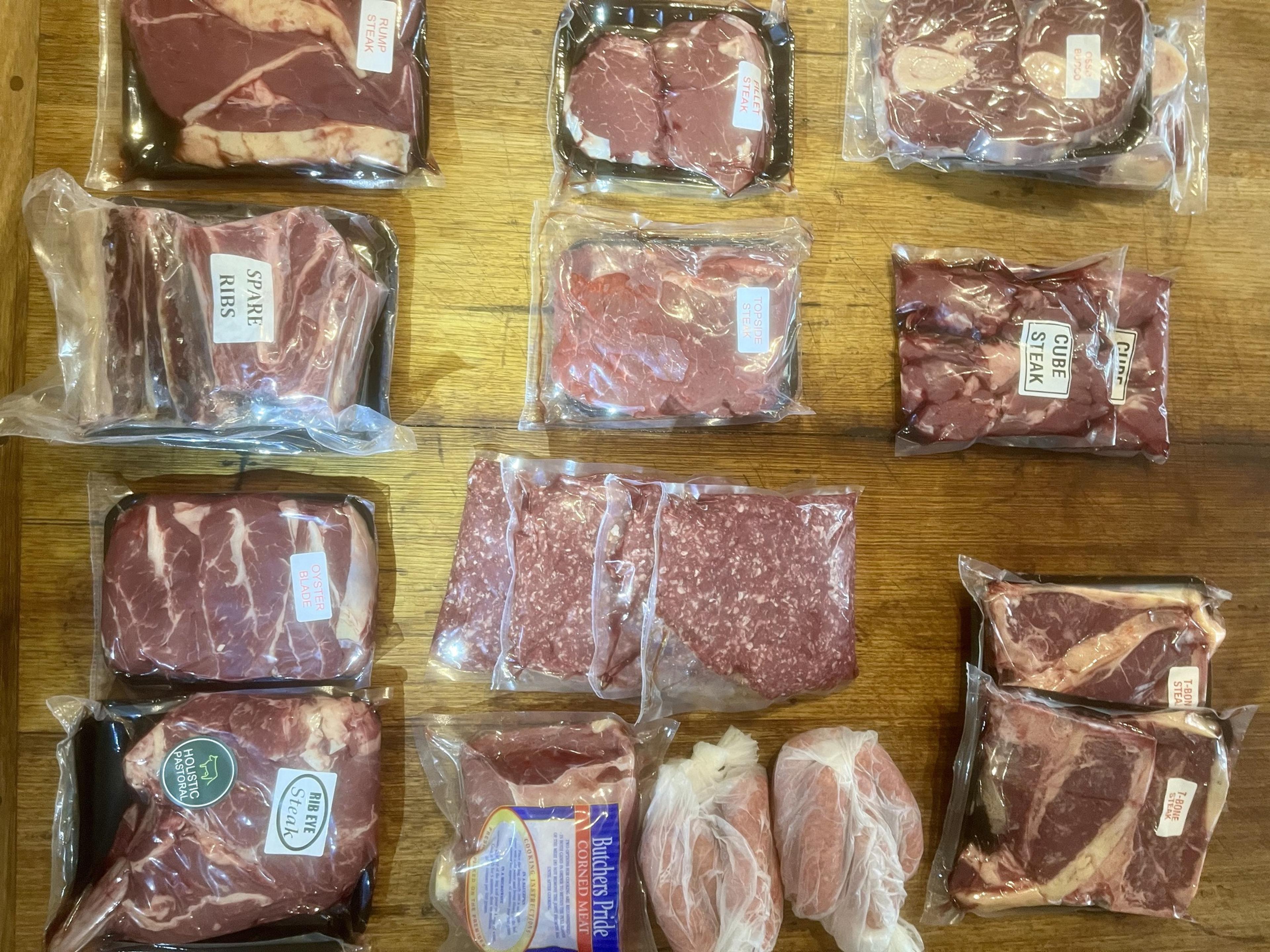Holistic by Nature, Dan Kelton on why farming is more than food
What started as a search for better food for their young family led Dan and Aldona Kelton from city life in Marrickville to farming across multiple lease properties in regional Victoria. Megan sat down with Wiradjuri man Dan Kelton from Holistic Pastoral to learn more about their journey into regenerative agriculture, how their approach is shaped by cultural values and lived experience, and why they believe you don’t need to own land to care for Country.
This interview has been edited for length and clarity.
M: First of all, can you tell us about what led you to start Holistic Pastoral?
D: I think it starts back when we were little kids, growing up in Wiradjuri Country. We lived on farms, worked on farms, and lived in remote areas. Most of the food that we ate ourselves as kids was stuff that we grew, collected, or hunted and killed. I think everyone's journey starts with those small memories of things they did when they were a kid. My wife, Aldona, grew up in the bush in the Blue Mountains, so I think that her upbringing was pretty pivotal for her as well.
Fast forward to when we’ve got our own kids, many years later, and we really wanted to provide the best food we could for them. We were living in the city, we'd just gotten together, and a little bit later we had our first kid, Jarra. We were looking around farmers' markets in Marrickville, in the inner city where we were living, trying to get back to the source of where our food came from. And it’s a bit of a slippery slope. All of a sudden, you look at yourself and you’ve got your own dairy cows, you’re milling your own wheat, you’ve got animals in the cool room out the front, and you’re making your own sausages! That’s kind of where it ended up.
We were looking to get to the origins of our food, and we kept going back to the source. We started buying a few head of sheep and putting them up at my mum’s in Wiradjuri Country with different mobs in Tumbarumba. Mum's family still has relatives there, and we were farming from a distance. We’d go up and kill a couple of sheep every few months and maybe a kangaroo or a deer to go with them and bring back the boned-out meat. Sort of the way I remembered how to do it as a kid. That was the family's meat supply for a while. Then we’d go and do it again.
At that point, we were living in an inner-city apartment in Marrickville, Sydney. It was very not us, but it was where we’d landed at the time. We were trying to get Jarra, our eldest boy, out into the bush as much as we could, just to have a connection to place and Country, but it was hard to find that. So we found ourselves escaping every weekend from the city out to the bush, to remote places where I’d worked as a guide or places that we knew were close to Sydney. Then Marley, our youngest, started to come along, and we were like, we've got to get back to the bush and back to the country. We needed to find somewhere where we could raise these boys with a connection to place. I got a job as an outdoor ed teacher at Rubicon Outdoor School, a government-run outdoor education school in Rubicon Valley, not far from Lake Eildon, on Taungurung Country. We jumped in on a one-year contract and got out there.
As soon as we landed, we started looking to lease Country and got back into sheep again, growing them ourselves. We were learning the whole time, how to process meat, relearning those things I’d probably partly known as a kid. All that knowledge started coming back through practice. We started selling a bit of meat to close-by friends. Friends sharing meat, as you do in the country. It has happened for years and will happen for years more. We thought it was good meat but I guess that was pre-regenerative grazing days.
I think about Charles Massy and his story. His studies talk about those pivotal moments in people and what inspired them to transition to regenerative agricultural systems. His thesis was about how 60% of the people he studied had these big, life-changing moments that shifted their paradigm and led them to regen ag. I don’t think ours was as grandiose as that, but we were living in the same place we were living with access to leased Country. My brother had come down, so we had more family there. We were running a couple of hundred head of sheep in this timbered country on the edge of the mountains. Lake Mountain was a couple of kilometres in the distance, up over the hills. The Country was full of wild dogs. We naively thought we could farm there.
I remember this old farmer, Claude, he'd been in the area a long time, a lovely bloke, very gruff but warm in his own way. He said, “Look, you want to farm sheep in this place, you’re going to have to deal with the dogs.” I was like, oh, we’ll figure it out. We’ll be as present as we can, do all the things we think we think we know how to do, put up electric fences, stop them. We’ll be right. He was right. We were wrong. Within about a year, we lost 60–70% of our mob, just decimated by wild dogs or dingoes or some kind of top-order predator. It was part of that system up there. They just kept hammering us. It was horrible, you’d rock up to the paddock and there were sheep you’d have to put down. It was gross. Horrible. I grew up on a farm with death all around me, but there’s nothing as bad as a maimed animal to really make you pay attention to what you’re doing. We ran into Claude on the way back. We were coming back down from a dismal day of canning sheep and trying to move them around and figure out what to do, and he’s like, “Oh yeah, you want to farm in this place? I told you you're going to keep losing. You’ve got to figure out a way to work with this place or get out.”
We started looking at different ways to protect the animals with alpacas, guard dogs and maremmas, and we stumbled onto poultry mesh that Joel Salatin was using over in America. He kept all his animals safe inside this poultry mesh, safe from foxes and things like that. We did lots more research, and found people using it to control bears over in America and I'm like, gee, if this can hold a bear back, surely that's a bigger predator than the dogs that we're getting! So we bought some, trialled it and that was kind of it, because as soon as you start to contain these animals, and we had big mobs, about 150 head of sheep, you run out of food very quickly inside these 50 by 50 metre squares. And it's like, well, we need to open up another one, and another one. All of a sudden you ended up in this daily rotation of animals and they're eating through this quarter hectare square of feed every day, sometimes quicker than a day. To give them more food you've got to keep opening up another cell and setting up, and you've got to come up with a way to get water to them and all of a sudden this whole system, that other people have been doing for many years, just sort of presented itself in front of us. We're moving them every day so they're not eating next to their shit, so all of a sudden you can start to escape from these pathogen cycles, which means no chemicals, no drenches, no vaccines. You end up with even better meat than we thought we had in front of us!
Joel Salatin, this master guru of regenerative ag, talks about these systems that fit together. Chickens that follow the sheep and he integrates pigs and rabbits and all sorts of things. So we started thinking, well, what else can we follow with these sheep, what will complement and what will work well in this little system? We started adding more and more things as you do when you get excited about new discoveries. Things went really well for a while until we discovered that you need to plan how much grass your animals need over a season. We ran out of grass because there was no rain and we'd been moving around. That led us to the Holistic Management system about how to manage, how to plan for the grass that you need ahead of you. And there were lots of learnings in between.
I guess that's a bit of a snapshot. I suppose, if I think back to what I've just said, it sounds like a big snapshot, but it's kind of the journey. One mistake or error leads to learning how to do something else because you've got a problem in front of you. The meat got better, the animals got healthier, and the landscape started to regenerate. There's this beautiful picture of a little property near Thornton up on top of a hill, we'd done a year's rotation of the sheep and then the chickens. It was hard and intensive, but there's this green wave that sort of creeps back into the landscape afterwards. You've got your animals at the front, and then you've got your chickens behind and then immediately behind that, the land is brown, and it's that animal impact. It's been picked over, it's been shit on, pissed on, it's been utilised and trampled. But then, if you look back a couple more days, it's green and greener and greener and greener. The stuff that we grazed a month ago, in my opinion, in those days, it was like, oh wow, it's green and ready to graze again. It's lush, and it spurred the grass on; it had livened up the microbiology in the soil, all these things I know so much more about now, it had triggered this succession of life in the land. And it was all caused by this animal impact at the front. In hindsight, we still had so much more learning to do, but essentially that’s how we started with regenerative farming. It was like okay, there's something here, there's good meat, good landscape, good animals.
I think the missing piece for us was learning about Holistic Management, how to make decisions that set you up well with all sorts of facets of your life: your family, your social cohesion, your juggling of time with kids, the landscape, the water system, the ecology, the biodiversity around you.
I think the missing piece for us was learning about Holistic Management, how to make decisions that set you up well with all sorts of facets of your life: your family, your social cohesion, your juggling of time with kids, the landscape, the water system, the ecology, the biodiversity around you. Learning how to make a decision that incorporates all these things that need to be considered, and sometimes they get left out when you make decisions. You might do something because it feels good but then it's not the best financially. You might do something because it gives you big profit but then the landscape might fall behind, your land, your connection and the health of your Country dies off because you ran out of feedstock over a summer or something. So that really changed how we manage things.
M: So it really was holistic.
D: Yeah that's right. I guess that launched the name for our business, Holistic Pastoral. We’re a pastoral company because we care for land and pasture, it’s more than just a farm. Pasture is like the ecosystem that comes with the grasslands. And being holistic, it's a bit of a reminder to ourselves to make decisions that include everything that's important to us, other than just the one or two things that we'd made decisions based upon in the past.
M: How far along the journey do you think you are? Are you starting to feel comfortable with where you're at? Do you want to buy a property?
D: Oh, things ebb and flow. It would be lovely to own a place and have a long connection to it. My wife's family came from Poland, and you know my family comes from here with spatterings of Irish ancestry. Our families have been drifting for the last couple of hundred years. I feel like I want to be the generation to find connection back to Country and to settle us. So I guess that's in the back of our mind a little bit.
Our families have been drifting for the last couple of hundred years. I feel like I want to be the generation to find connection back to Country and to settle us.
In terms of farming and where we're at, I think we are evolving every day. We're in a really hard season at the moment. At the beginning of this year we did grass calculations and bought lots of cattle because we thought we really needed to spur this supply chain along a bit. It’s a good example of probably not making the best holistic decision because we've just had to sell a lot of the cattle that we bought. Last night we were having a good chat about it, like geez, we really went a bit hard and a bit fast. We probably should have slowed down a bit and thought about quality as opposed to quantity, on the back of these terrible prices that we've had to sell cattle underneath. My wife is a lot savvier than me with things, but I wouldn't say I'm a businessman. I'm terrible at finance. So there's a lot of growth in that financial side of things. There's so much learning there. It's not what I love. My love is Country, growing things and working with animals, seeing them, moving them every day to new grass. They're the things that you get passionate about. But, to be able to do that and to make it viable and sustainable, you've got to be able to tell people about the things that you're doing, tell them about why your stuff is a little bit different to the stuff they're buying at supermarkets, and help people learn that. So I think we've got a lot of growth to go there, a lot of learning to do.
Look, managing and caring for Country, we make our decisions with that as the priority. Of all the things you might slip up on, we still do that really well. We look after animals really well, and I think the farming side of things, the being on the land, caring for the places, I think we do that well. We've set up maybe a dozen different new farmers who are running their own operations on regen farms. And it's all people that we've worked with for a year or two and then they've gone, "Oh look I really want to do this, can you show me how to do that?" We’ve kind of become consultants without even knowing it. If you take the bigger view, you can see all these patchworks of landscape that are being managed in a better way now because we've set people up on them. We've established a little bit of a supply chain, set these other people up to be autonomous on their land, which I’d never anticipated would happen.
I think one of the things we do really well is we make decisions for the health of the land. What I've learned is, if you don't have land, you have nothing. It's so important to have that and to have it in good health.
M: That's fantastic! It's expanding and sharing that knowledge. In terms of your Wiradjuri heritage and cultural values, how has that influenced the way you work?
D: I think it's that care for Country. Like I said, I think one of the things we do really well is we make decisions for the health of the land. What I've learned is, if you don't have land, you have nothing. It's so important to have that and to have it in good health. I think paying attention to landscapes is important. Lots of farmers are good at that but I think you notice small things in the landscape change and I think that's something that First Nations people do really well. Those small details are often the indicators of the health of Country. The plants that grow there are the best indication of prior treatment of Country. The absence or presence of different plants can tell you so much about a place and how it's been managed in the past. Knowing where your food is coming from is really a very Indigenous concept, that the food and the land where they end and begin is blurred. The land, when in a good shape, gives you the food that you need, and then you need to repay that by not flogging your Country out when it doesn’t have the capacity to be growing things. Knowing where your food comes from is one thing, but recognising that there's a flow of energy that comes from that land into your food and then into you, and that continuation of you and your food and your land, that energy flows through all of us. When you breathe air from a place, when you drink water, when you eat food that's grown on that land, spiritually and scientifically, you're taking that land into you. I love the notion that well cared-for soils end up in you and in the body.
M: That's very cool. Can you walk us through a typical day on the farm?
D: Well, there is no typical day, number one. We’re lease farmers, like I say, we’re a bit like gypsies. It depends on where we’re farming, what we’re doing, and the season. When the kids are at home, we get them out the door and off to school. On weekends, we’ll get them up and fed. Most of the food we eat, we grow ourselves. We eat from the land first and get ourselves fueled up.
Then we shoot off to move animals. If we're in growing seasons, we’ll do a daily move of cattle. So when we get out to one of the places, we're looking at cattle health, you look at land, you look at the impact from the day before. You do a quick calculation about whether you were right or wrong with the grazing cell size based upon the behaviour of any of those three variables. The next cell size is set up for the day, and then I'll set up the next day ahead. We’re always operating two or three days ahead if we can. If we've got two mobs, then we'll replicate that over at another lease block.
Because we're spread out over different locations, we try and do as much as we can at one place before moving on to the next. Maybe there's water to set up ahead, maybe there's some fence lines to build or repair. Maybe you've got to do a quick check of boundaries. Maybe you've got another move coming up ahead, so we'll set up an alleyway or a laneway. We use a lot of temporary electric fencing. We set up for the day as much as we can on whatever farm we’re on.
Sometimes you go and spend half a day, or a couple of hours, having a cup of tea with the landowners. I swear farming is more travel and conversations than anything else. You spend more time in the car or talking to people than you actually do farming. Sometimes that's annoying when you have a backlog of jobs to do but then you pinch yourself and slow down, remind yourself that this is a really important part. It's community-building, I think.
Then, you go and replicate things at another farm. Maybe you’ve got sheep at that one, sometimes we're doing pigs at different places, or meat chooks. When we're doing the meat chicken runs, that's more of a regular day. You've got more chores to do with the chickens because you've got to mix feed, take them out to paddocks, set up the next cell ahead, move the waterers, move the feeders, and tow the little homemade chicken caravan through knee-high grass, which is always bloody hard work.
The chooks are amazing. We love doing them. We do two or three batches of those a year. They just grow so fast. Sometimes, you'd show up to a lease paddock and they know the sound of your ute. These little beauties, when they see us, they run the length of the paddock and they flap, it's like they're going to take off. It's just the way food should be grown. You know, they should be free to do this. And then you pull them along in the chicken caravan to the next cell, and they just go nuts in the new paddock. They go straight for the green shoots, or they'll start scratching and chasing crickets and frogs and just doing what animals should do. It brings us lots of joy. If someone else had picked them up from the brooder and not us, they would have been raised in pretty shit conditions in a factory.
Lambing time is always good because you've got little bundles of fluff. Calving is fun and a little bit exciting when you have to ear tag cattle and things like that. And you're waiting to see what colours they'll come out because we've got different coloured cattle.
M: That sounds fun. What has the community's response been?
D: I think we attract like-minded people wherever we go. All humans do that. Subconsciously, the people we get to meet are on our wavelength already. We don't do farmers markets just because we're so time-poor, but when we do meat deliveries, I've learned to set aside vast amounts of time for more talking. I remember the last meat drop we did locally, and in my mind, it was a half-day job but I got back home in the dark! Everyone invited me in for a drink of water or a cup of tea. You know, these lovely old people, cute old retired couples, and you're sitting in their lounge room, and they're bringing you biscuits and drinks, and they want to know your story. So it's like the farmers market payback. People are really welcoming. I guess they've already bought into what you're doing when they're buying the meat from you.
And with regards to farmers, the one thing I've learned is that all farmers have so much in common. I didn’t grow up on a cropping operation, it was always livestock, but you look at croppers and how intensive that is, and once I started learning about food systems and regen farming, I was like, oh my god, how could you ever crop? You almost hold that as a personal slight against someone who crops. But then, when you get to meet people and you look at the soil, the legacy that they've left, yeah, it's industrial, but they have cared for this place in their own way still. They have paid attention to mineral balances in the soil. They have paid attention to things like erosion. In their own way, they’re caring for Country. That’s a big learning for me this year, all farmers love Country.
I think people have just got different priorities when they're making decisions. Maybe it's all about paying off a house, maybe they've got to pay land off. Maybe they’re so far in debt that they’ve got to do whatever they can and so it’s all about yield for them, not quality. So, getting to know these, I suppose you call them conventional farmers, they're really welcoming people. They're interested in what you do. They call some of the seeds that you're putting out ‘bird seed,’ and they question your timings and things like that, but I find we have way more in common than what we don’t have in common.
And with livestockers as well, I know what it’s like when you run out of food and the decisions that you have to make sometimes don’t put land ahead. I know what it’s like to go through those tough times as a farmer and make hard decisions. I remember back to before we learned about Holistic Management, you're kind of doing it by what you’ve done in the past, by what the neighbours or your previous relatives have done. It's a bit tricky. I admire people who break out of those paradigms. Especially if you're a seasoned farmer or third or fourth generation and you’re asking questions about why we're doing things. I think that's beautiful. I think that's brave, to be questioning things instead of just doing what you’ve done in the past. I do lots of consults, and most of the people I work with are new people coming into farming. They've bought new land, especially in this region. There’s a lot of people buying up little blocks. I think those people are so open. And I think it's easy to start an enterprise with the right things in mind. I think it's way harder to shift and to change. When I hear stories about people like Colin Seis and Charles Massy, those absolute legends, I think they're brave. I think they're so brave to have gone through that. Maybe they had no choice, maybe that’s what drove their bravery, I don’t know. I love it when we run a field day and an old farmer from the district shows up. I love that. I love that there are people out there who are still trying to learn things.
M: Love that! How do individuals and organisations like Sustainable Table better support First Nations farmers? Or farmers in general?
D: I think you do a good job already. When we applied for Sustainable Table’s Regenerative Food and Farming Map, I thought we wouldn’t qualify because we’re lease farmers and we don’t own the Country we’re on. Anyway, I started the application and discovered it’s not about ownership, it’s about the custodianship of the place. I thought it was amazing. I thought, well this is really progressive. This is a great way of viewing farming. There are a couple of people in Melbourne who have found us through Sustainable Table. Just out of the blue, a lady recently emailed to say, “Oh I just read on the website that you’re a First Nations enterprise. I’m so proud to be buying food from you. Thank you.” I was like, wow, what a nice thing to say. And what an endorsement for a platform that told someone that little piece of our story.
I think connecting with other farmers was a really big thing. When we were starting out, trying to ship stuff around the country, I remember looking on Open Food Network for other farmers in our area, and I immediately got in touch with them. I asked questions like, where are you getting your boxes from? What company are you using? How do you package that? I find most people in our space are really happy to share.
M: What do you think the future of agriculture is in Australia?
D: I feel like everything will be driven here by money and cost. At the moment, when you look at big producers, fertiliser and diesel costs are just rising and rising. It’s probably not the way you would want it to be driven, but they’re going to have to find cheaper ways to do things. People are already looking at biologicals to enhance crop production. Previously, people would not have been contemplating worm juice, compost teas and things like that on a broadacre but I think the science is growing. This stuff is working. So, people on a broad scale are looking for a cheaper way to fertilise crops. I think that will change the big end.
I think the little end is rolling along at a rate of knots. When I talk about little end, it’s small producers like us. So many people, when you do consults, are like, “Well, how do I get this produce to people?” And not that we’re experts at it, but I tell them how we do it. So there’s this interest in cutting out the middle person and getting consumers directly in touch with their meat. You get so many questions about, “What’s your supply chain? How does it work? How do you do it?” It’s not easy. It’s probably the trickiest part of the whole business. But when you get it right, I think it’s the most profitable. And that’s the way it should be. The hardest work is coming from the people with their hands in the soil, the farmers growing it, the ones in the paddocks. I think they should be paid more. And when you do sell it yourself, you’re getting a better price for it. There’s so much interest in that.
I feel like it’s an exciting time to be in farming, because people are looking at how to do things in a simpler way, in a healthier way, in a more cost-effective way.
I’m hopeful. I’m hopeful things will change. I like that concept Charlie Massy talks about, how we’re at the forefront of a new way of thinking about the world. I feel like it’s an exciting time to be in farming, because people are looking at how to do things in a simpler way, in a healthier way, in a more cost-effective way. In some cases, we’re stepping back, looking at information from the old people and how they farmed. And, in those earlier days before the Green Revolution, how people farmed then. It feels like there’s momentum and like people want to know and be connected to where their food is coming from.
I’ve been trying to learn lots about how you put the best quality product in front of people. I’m learning a lot about nutrient density. Over in the States, they’re measuring nutrient density in fruit and vegetable crops with spectrometers and things like that. When you can show a producer or a consumer that the meat that you’ve grown, because it’s grown in a free-range, grass-fattened and grass-finished system, has a better omega-6 ratio, it helps them to understand why you should be paying more. Or in a case of two carrots in a supermarket, you can scan the two items and see one is cheaper, but when you compare the nutrient density, the one that is two times the price is also two times the nutrient density. I think that will become more important as people are seeking healthier food.
Hopefully, there’s lots of space for little small-timers like us who provide food for their small communities. That’s where I’d like it to go. People interested, people knowing their farmers, and regions being able to supply food for themselves. I always think back to that whole COVID shock that we all went through, and we grow so much food in Australia, we grow so much food in these tiny little food-growing regions. But everything gets shipped off through supply chains. And then, when we needed it, because supply chains were closing down, we couldn’t feed our own communities with this stuff. It’s just nuts. Our family motto is that we need to feed ourselves first with this good food, and then we’ll feed the people around us. We should be doing that on a regional basis too. Let’s feed ourselves, let’s make sure everyone’s economically got access to this food, and let’s make sure it’s the best food we can grow.
M: We’ve got two more minutes. Is there anything else you’d like to share that we haven’t covered?
D: I think a paradigm I’d like to bust is that you don’t need to own land to be a farmer. It’s not easy and it’s not the way I would probably choose if I had alternatives. But there is so much land out there. And it’s all just begging for custodians and caretakers to look after it. This concept of owning, it’s such an industrial and a white point of view, that Country is owned. Sometimes it’s enough to be connected to the place and to be sourcing your own energy from the place. Do you ever really own the land? You might take a mortgage out on a farm and you’ve got the rights to it for your short life. But then give it a hundred years down the track, it might not even have stayed in your family. So some people pay for the privilege to call it theirs, and some people don’t. Maybe we need to be a little more flexible with our concept of what Country is. Do you need to own the land to be part of it? I think we’re always going to be here for these short spaces of time, and the best you can do is to care for it and hand it on to the next generation as best as you can. I think the old people, the Elders, understood that. The whole concept of ownership was vastly different. It wasn’t owned. It was them and they were part of it.
Learn more about Holistic Pastoral on their website or follow them on Instagram and Facebook.
